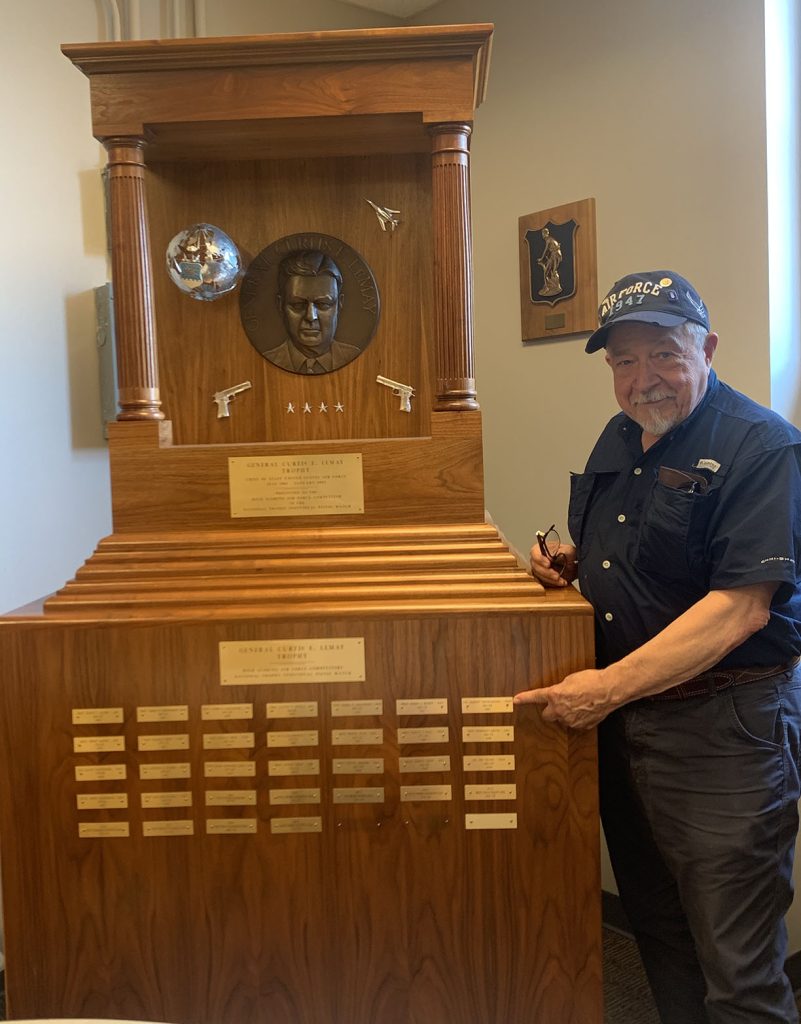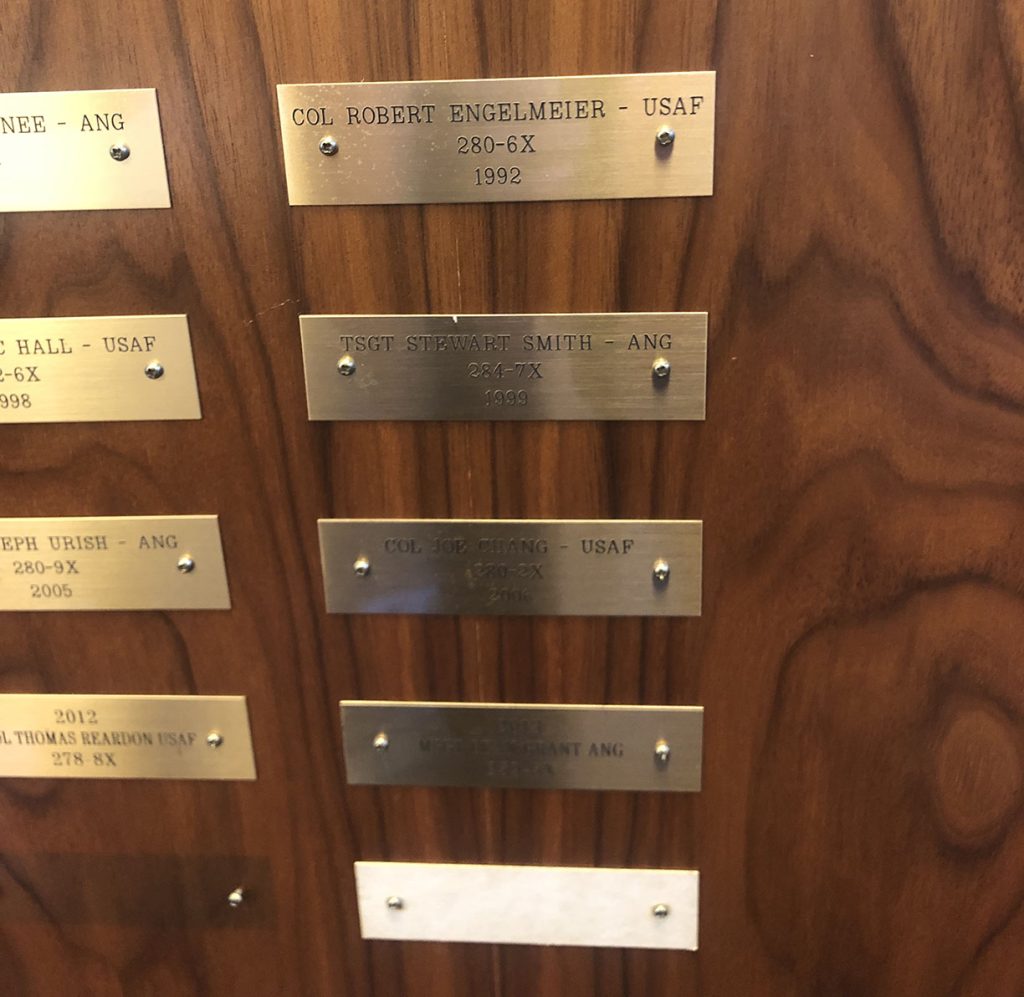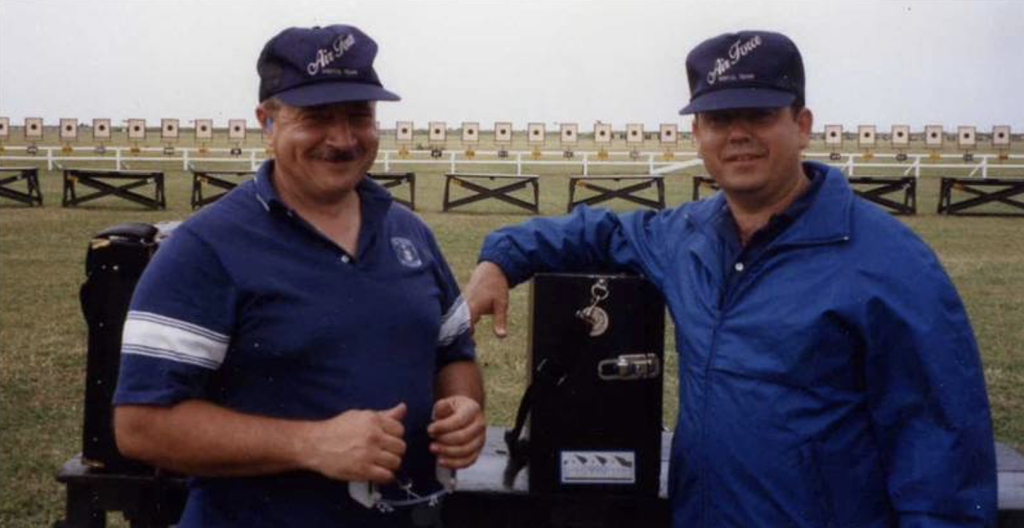Former Air Force Pistol Member Makes First Camp Perry Visit in 28 Years
December 15, 2022
Civilian Marksmanship Program▸The First Shot▸Former Air Force Pistol Member Makes First Camp Perry Visit in 28 YearsInspired by the many adventures he experienced as a member of the Air Force Pistol Marksmanship Team back in the late 1980s and early 1990s, Dr. Robert “Doc” Engelmeier from Pittsburgh, Pa., created his own exposé. Documenting his excursions, including to Camp Perry, he goes into remarkable detail about being a competitor during that time period, the awards he accumulated and the friends he made along the way. The CMP will be posting the piece through a series on our online publication, The First Shot, featuring fascinating commentary and vintage photos for readers to enjoy.
We begin with our own account of Doc’s 2022 Camp Perry trip – a return after a three-decade absence – where he made even more memories on the historic grounds.
Dr. Robert “Doc” Engelmeier from Pittsburgh, Pa., made a sentimental trip in 2022 – back to the Camp Perry National Matches in Ohio for the first time in nearly 30 years.
“We had the time and determination this year,” Doc said of the trip, having been too busy to return since 1994. “It worked out really well for us.”
Doc served a 24-year Active Duty career in the Air Force, retiring with the rank of colonel in December 1995. He also spent time in the Massachusetts Air National Guard. During his time in the military, he spent nine years as a member of the Air Force Pistol Shooting Team where he reached several notable successes, like earning Distinguished Pistol Badge #278.
“That was a big deal,” Doc said. “I value my Distinguished Badge more than my Legion of Merit (an exceptional military award) – because I had to perform.”
He keeps the badge in a display box in his home, along with his many honorable awards.
Such high achievements from his career include imprinting his legacy forever on two trophies from the annual Camp Perry National Matches back in 1992. One was the General Carl Spaatz Trophy, awarded to highest scoring Air Force competitor in the National Trophy Team Pistol Match, while the other was the General Curtis Lemay Trophy, presented to the highest scoring Air Force competitor in the National Trophy Individual Pistol Match. Though he didn’t know it until 25 years later, Doc was the first Active Duty member to achieve the Lemay Trophy.


“I wanted to see my name engraved on there,” he said, explaining how he had never seen the trophies before the 2022 trip.
Outside of the trophy room, the spirits of his old teammates were as present as ever on the legendary grounds. Some have passed away, while others have been able to keep in touch with Doc over the years. One such teammate is Gary Foster, who made the trek to Camp Perry with Doc this year. Gary now lives in Tennessee and met up with Doc in Pittsburgh, where both men made the three-hour, rain-drenched ride together – swapping stories of their time at Camp Perry.
“Some might even be true,” Gary joked.

Gary has marksmanship talent of his own – earning Distinguished Badge #300 and making the President’s Hundred, which is a prestigious National Matches accomplishment. He has since spent time training others and even competes on his own, where people see him as a “Big Fish” on the range.
“But I’ve been to Nationals – I’ve SEEN the Big Fish!” Gary said with a smile.
The men stayed in nearby Port Clinton, where everything has, understandably, changed over the last three decades. The men toured their old Camp Perry haunts and discovered additions they had never seen before, like the Gary Anderson CMP Competition Center and its attached 80-point indoor air gun range.
At the time of their visit, a National Junior Three-Position Air Rifle match was taking place. The men spent two hours at the facility, amazed at what they saw.
“I was very, very impressed by all that! The building and everything,” Doc said. “That’s going to save shooting, believe me. All those young kids doing it.”
“The sophistication of the guns,” he went on. “We’re .45 hard ball shooters – a throwback to World War II for crying out loud. I wouldn’t even know how to shoot those guns!”
Back outside, they marveled at the accommodations now available on base and took a stroll down the base’s Commercial Row, where they ran into some old friends.
Commercial Row also sparked a memory for Doc. It was there that he met Bill Jordan, a famed member of U.S. Border Patrol around the time of World War II and the Korean War – a meeting Doc discusses further in his memoire. At 6’6” tall, Jordan was larger than life as a competitor on the range and within his career.
“He was in cowboy-like gunfights at the border,” Doc said of Jordan. “He was quite a guy – but only at Camp Perry would you meet people like that.”
Doc had initially become involved with the Air Force team on a whim, when his wife brought home a magazine she had discovered in a doctor’s office waiting room. It mentioned team tryouts at nearby Randolph Air Force Base. Doc had just finished his residency on his way to becoming a maxillofacial prosthodontist and thought – why not?
“My wife was pushing me, ‘You’ve carried these guns around all these years – why don’t you start shooting again?’” he explained. “And I just had this feeling that it was the right thing to do.”
“I’m sure I got the invitation because I was a colonel,” he joked. “They were trying to be nice to me.”
Though he hadn’t planned to join a marksmanship team, his time there sparked experiences he has never forgotten.
“It’s amazing that a beat-up old magazine that my wife brought home from the doctor’s appointment led to that wonderful nine years,” he added.
Those years brought along with them tours of the Camp Perry National Matches, treasured relationships and a narrative full of exceptional tales that have lasted a lifetime.
“We had a great trip – we had a great time,” Doc said. “This was a gift.”
More about Doc Engelmeier:
In his professional career, Doc was a maxillofacial prosthodontist – essentially, a dental artist. Maxillofacial prosthodontists assist cancer patients, accident victims or anyone else who has lost body parts by creating a prosthetic to replace the missing piece.
Using a photo of the person or his imagination as his guide, Doc’s job was to sculpt the missing pieces, whether they be ears, nose or a mouth palate, and attach them with a removable apparatus – as if it was never missing.
“I always tell people I’m in the spare parts business,” he joked.
His adulthood began as a steel worker in Pittsburgh’s West End as he worked his way through college. He entered the Air Force in 1970, where he entered a three-year prosthodontic residency. He was then sent to the MD Anderson Cancer Center in Houston where he learned more about maxillofacial prosthetics.
He took a break from Active Duty from the Air Force 1972 to 1974 when he entered into a private practice in Provincetown, Mass. – a popular tourist destination. He was the first year-round dentist in town. After two years there, he went back to Active Duty, stationed at nearby Otis Air Force Base, to get more education. The Air Force, wanting him to receive the best training, even sent him to civilian institutions to receive extra guidance.
“I’m really grateful for that,” he said.
He’s been a professor at the University of Texas and the University of Pittsburgh – passing on his knowledge to the next generation. He has lectured on a national level and has written around 70 scientific articles in refereed journals, reviewed by other professionals in the field, with another 30 articles in non-referee journals. He’s also co-authored two textbooks. Now, he teaches at a dental school in Erie, Pa., and finds himself with more time than he knows what to do with.
Naturally creative as a sculptor and painter while also being a published author got him thinking that maybe, with his extra time, he could combine his creativity with his writing skills to create a descriptive look into his life’s adventures.
Click here to read more about Doc’s history through his Air Force Shooting Team editorial, A Hardball Odyssey.